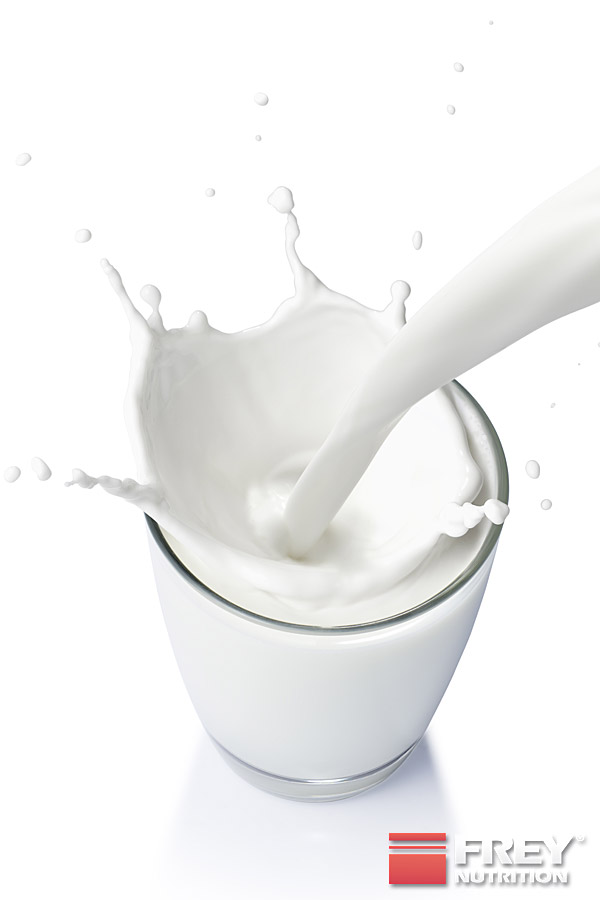THE EFFECTS OF CALCIUM ON FAT LOSS
SUMMARY: REDUCTION OF OBESITY RISK BY 18%, REDUCTION OF BMI BY 0.3 UNITS AND INHIBITION OF OVERWEIGHT.
Milk and dairy products are considered to be potentially "fattening" due to their relatively high fat content. However, the available evidence points to the opposite. A number of epidemiological studies in recent years have consistently found an inverse relationship between calcium intake and obesity or body fat percentage [3]. For example, in the new analysis of the US health survey NHANES III, the risk of obesity decreased in proportion to calcium intake [5]. A meta-analysis of other cross-sectional studies confirms these results. It shows that a daily additional intake of 100 mg of calcium is associated with a LOWERING THE BODY MASS INDEX (BMI) by an average of 0.3 units [1].
It also allows the assessment that calcium intake alone can explain up to 10% of the variance in body fat content [1]. Recently, two longitudinal studies were also evaluated in summary. A low calcium intake was associated with an average weight gain of 0.42 kg per year. In contrast, the highest calcium intake correlated with stable body weight [2].
Since milk and dairy products are the most important sources of calcium, the CARDIA study in the USA examined their influence on the development of obesity in 3,157 adult men and women, with 2,234 subjects still having a normal weight (BMI < 25) and 923 overweight (BMI > 25) at the start of the study [4]. After ten years of observation, the incidence of developing obesity (> BMI 30) was 45.1% among those who were already overweight at the start and then consumed an average of more than 35 milk and dairy product meals per week. If, however, they ate fewer than 9 milk meals per week, the incidence rose to 65%.
In summary, the risk of obesity was reduced by 18% for each additional portion of milk and dairy products per day. This effect was observed for fresh milk and milk drinks as well as for cheese, sour cream, butter and sweet cream, yogurt and milk-based desserts. The fat content of the products made no difference. A similar connection was also found in those who were of normal weight at the start of the study, although this did not reach statistical significance. A number of randomized controlled intervention studies have also been conducted on this issue. They confirmed the epidemiological data: in subjects of growth age, a high calcium intake led to reduced fat storage compared to a low intake. At the same time, an increase in fat-free body mass was found.
ACCORDING TO STUDY RESULTS, CALCIUM CAN INHIBIT FAT ABSORPTION AND STIMULATE LYPHOLYSIS (= FAT BREAKDOWN).
In adults, too, a high calcium intake inhibited the development of obesity. A calcium-rich diet increased weight loss in overweight people compared to the control group with a low calcium intake, with primarily body fat being lost, but not lean muscle mass [1]. Two biologically plausible mechanisms have now been researched, both of which could independently explain a difference in weight: On the one hand, calcium binds fat in the intestine and thus inhibits fat absorption. On the other hand, calcium intake stimulates calcitropic hormones (PTH and vitamin D), which leads to an increased intracellular calcium content in the adipocytes. This in turn PROMOTES LIPOGENESIS and lipolysis [3]. However, since controlled intervention studies show greater weight loss with a calcium- and milk-rich diet than can be explained by the above-mentioned mechanisms of action, it is assumed that milk and milk products must contain other compounds that trigger additional anorectic effects [3].
These findings make it clear that nutritional advice should not be based on ingredients and energy content in isolation. What is decisive is the actual influence of the consumption of the relevant foods on health-relevant endpoints.









